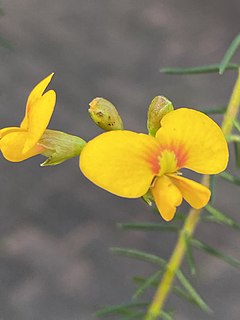
Dillwynia retorta, commonly known as eggs and bacon, is a species of flowering plant shrub in the family Fabaceae and grows in New South Wales and Queensland. It is usually an erect shrub with thin, smooth, crowded leaves and yellow flowers with red markings.

Callicarpa pedunculata is a shrub or small tree in the Lamiaceae family native to both Queensland and New South Wales.

Alternanthera bettzickiana, commonly known as calico-plant, is a species of flowering plant in the family Amaranthaceae. It is commonly used as an ornamental edging plant. Native to South America, its cultivar 'Red' is similar in appearance to some of the Alternanthera dentata and Alternanthera brasiliana varieties.

Olearia asterotricha, commonly known as rough daisy-bush, is a species of flowering plant in the family Asteraceae. A tall shrub with white, mauve or blue daisy like flowers growing from the Blue Mountains in New South Wales to western Victoria, Australia.

Hakea eriantha, commonly known as tree hakea, is a shrub or small tree endemic to the east coast of Australia. It has white flowers on a woolly stem in leaf axils, long narrow leaves with reddish new growth. Found growing at higher altitudes in moist or sclerophyll Eucalyptus woodland.

Hakea macrorrhyncha is a shrub in the family Proteaceae native to Australia. A restricted species of north-eastern New South Wales and south-eastern Queensland.

Scaevola acacioides, is an erect, spreading shrub in the family Goodeniaceae.

Scaevola basedowii is an erect multi-stemmed shrub in the family Goodeniaceae, endemic to Western Australia, the Northern Territory and South Australia.

Scaevola browniana is a shrub in the family Goodeniaceae, endemic to Western Australia, the Northern Territory and Queensland.

Scaevola glandulifera, the viscid hand-flower, is a shrub in the family Goodeniaceae, endemic to Western Australia.
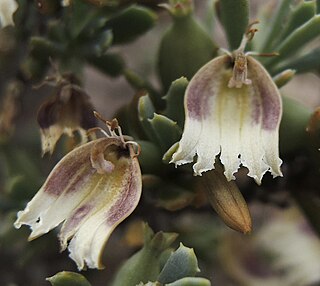
Scaevola collaris is a shrub in the family Goodeniaceae and its native range is five mainland states/territories of Australia: the Northern Territory, New South Wales, South Australia, Queensland and Western Australia.

Scaevola nitida is an erect shrub in the family Goodeniaceae, native to Western Australia. It grows to a height of 0.3 to 3 m, and its blue-purple flowers may be seen from August to December.

Scaevola humifusa is a prostrate shrub in the family Goodeniaceae, native to Western Australia. It grows to a height of 0.01 to 0.5 m, and its white-cream/white-blue flowers may be seen from August to November or January.
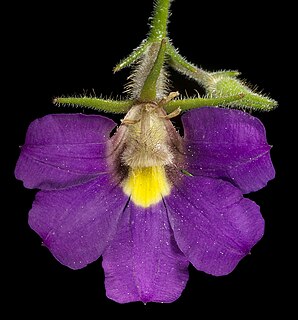
Scaevola phlebopetala, commonly known as velvet fanflower, is a herb in the family Goodeniaceae and is endemic to Western Australia.
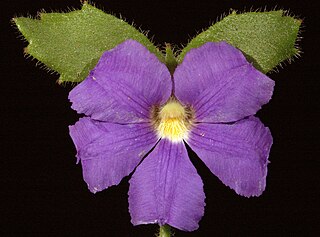
Scaevola pilosa, commonly known as the hairy fan-flower, is a perennial herb in the family Goodeniaceae. It is endemic to the southwest of Western Australia.

Scaevola repens is a shrub in the family Goodeniaceae, endemic to the south west of Western Australia.

Dampiera alata is a plant in the family Goodeniaceae, native to Western Australia.

Goodenia arthrotricha is a species of flowering plant in the family Goodeniaceae and endemic to south-western Western Australia. It is an erect perennial, herb with linear to lance-shaped leaves with the narrower end towards the base, racemes of blue flowers with linear bracteoles at the base, and oval fruit.
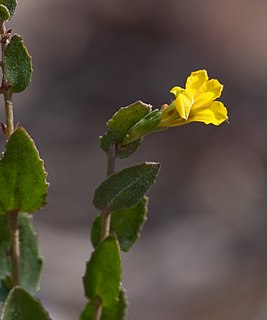
Goodenia benthamiana, commonly known as small-leaf goodenia, is a species of flowering plant in the family Goodeniaceae and is endemic to south-eastern Australia. It is an aromatic undershrub with stem-clasping, egg-shaped to elliptic leaves with toothed edges, and yellow flowers arranged singly or in groups of up to three in leaf axils, with leaf-like bracteoles at the base.

Scaevola striata, commonly known as royal robe, is a species of flowering plant in the family Goodeniaceae. It has blue fan-shaped flowers, and is endemic to Western Australia.























